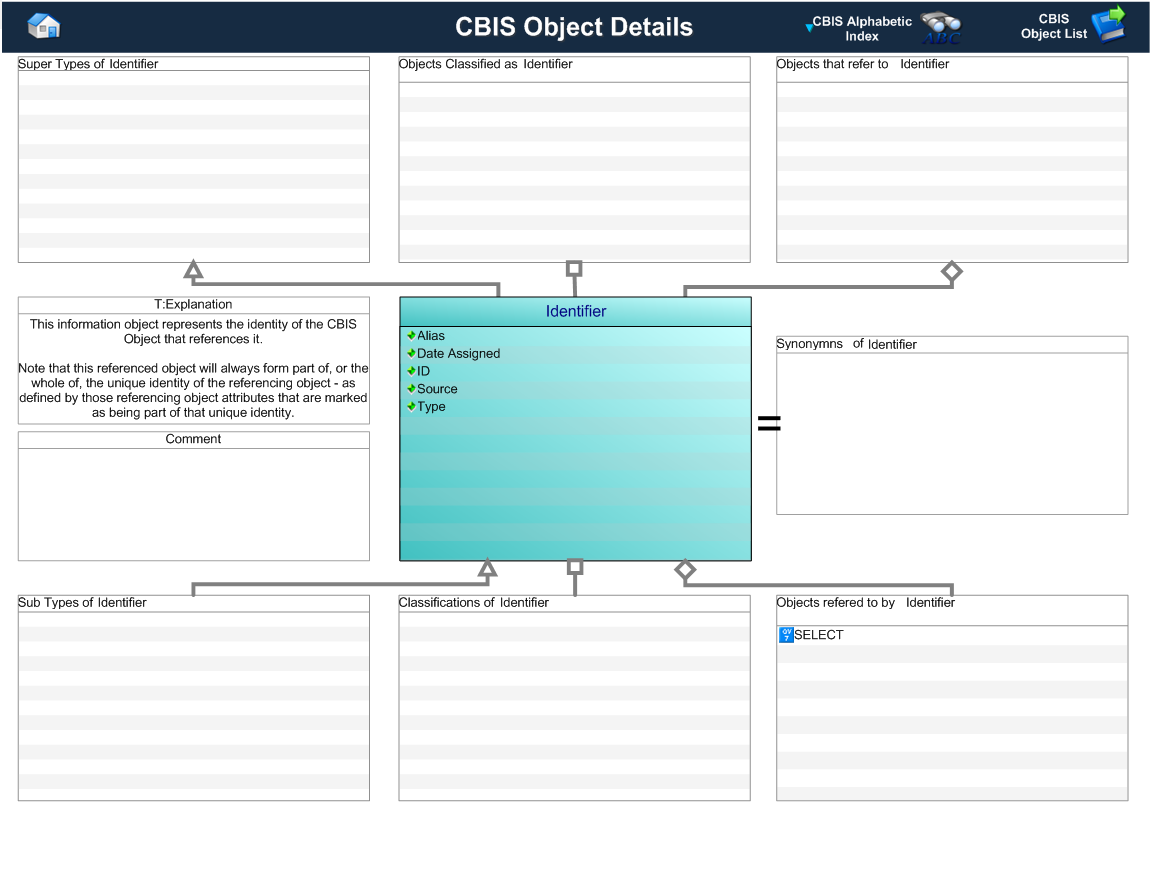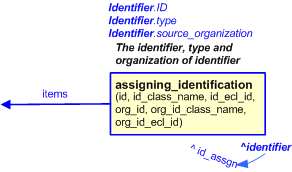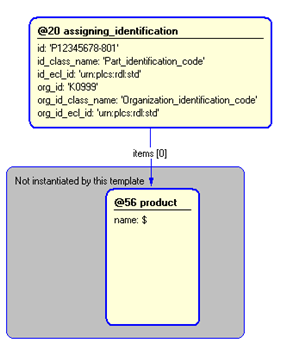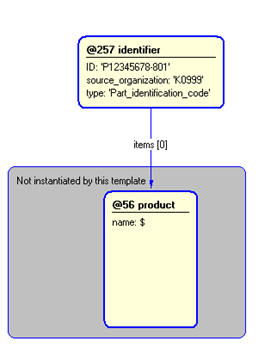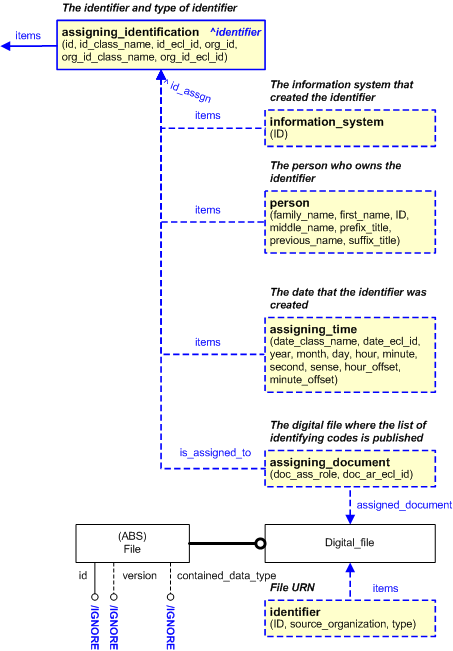Template:— identifier (ident)
Context:— UK_Defence |
Date: 2009/04/17 09:34:16
Revision: 1.2
|
This section specifies the template identifier.
NOTE
The template has been defined in the context of
UK_Defence.
Refer to the business context for details of related templates.
NOTE
An explanation of a template and the associated instantiation path is
provided in the
Template overview
section.
This template describes how to represent a UK_Defence identifier, using
Identification_assignment.
For further information about the representation of an identifier, see below.
The Identifier business object is used by those UK_Defence Data Exchange
Specifications to represents the identity of the CBIS Object that references it.
Figure 1 —
Identifier:
The definition of a Identifier object is:
This information object represents the identity of the CBIS Object that references it.
Note that this referenced object will always form part of, or the whole of, the unique identity of the referencing
object -
as defined by those referencing object attributes that are marked as being part of that unique identity
|
Attribute name
|
Attribute description
|
Attribute type
|
Optionality
|
| Alias |
This is a reference to another Identifier that has been defined to be an alias of this Identifier.
For example, an organization may assign an internal part number that is an alias for an OEM part number.
|
Intrinsic |
Optional |
| Date_assigned |
This is the date and time on which the object that references this Identifier was created. |
Intrinsic |
Optional |
| ID |
This is the identifier that is defined by the associated Source. |
intrinsic |
Mandatory |
| Source |
This is the reference to the source that created the associated ID.
This will usually be an organization.
System generated identifiers will refer to the information system that created them - for traceability.
Occasionally, a person will create an ID for an information object..
|
Organization, Person or Information_System |
Mandatory |
| Type |
This is the name of the type of the ID. |
intrinsic |
Mandatory |
Table 1 — Identifier attribute details
The EXPRESS-G diagram in
Figure
2
shows the templates and EXPRESS entities that are required
to represent the template
"identifier".
The text highlighted in blue shows the template parameters.
Figure 2 — An EXPRESS-G representation of the Information model for identifier
The graphic for the template to be used in other EXPRESS-G diagrams
is shown in Figure
3
below.
Figure 3 — The graphical representation of the identifier template
The following input parameters are defined for this template:
This is the identifier that is defined by the associated Source.
The organization or information system that created the associated identifier. Additionally
a Person or Information System could be defined when either of these are the source; see characterizations
This is the name of the type of the class used to classify the identifier and so
provide the role or reason for the identification.
The following classes and their sub-classes can be used:
The items to which the identification is assigned
The following reference parameters are defined for this template:
%^target = $identifier.identifier%
The following parameter combinations specify a uniqueness constraint:
Unique constraint: Unique identifier
Any given identifier shall only be assigned to an item once.
The instantiation path shown below specifies the entities that are to be
instantiated by the template.
A description of templates and the syntax for the instantiation path is
provided in the
Templates Help/Information section.
/
assigning_identification(
id=@ID,
id_class_name=@type,
id_ecl_id='urn:plcs:rdl:std',
org_id=@source_organization,
org_id_class_name='Organization_name_or_identification_code',
org_id_ecl_id='urn:plcs:rdl:std',
items=@items)/
%^identifier = $assigning_identification.id_assgn%
The instance diagram in Figure
4
shows an example of the EXPRESS entities and templates that are instantiated by the template:
/identifier(items='#56', ID='P12345678-801', type='Part_identification_code', source_organization='K0999')/
(an illustration of the consolidated identifier template is shown in
Figure
5 below.)
Figure 4 — Entities instantiated by identifier template
The instance diagram in
Figure
5
shows the graphic symbol for the template that is to be
used in other instance diagrams. The example template is:
/identifier(items='#56', ID='P12345678-801', type='Part_identification_code', source_organization='K0999')/
Figure 5 — Instantiation of identifier template
The following section details how the
identifier
template can be optionally characterized by assigning
other constructs to it. These are characterizations commonly
applied to the template. The ISO 10303-239 EXPRESS model may enable
other assignments to the entities instantiated by the template.
The EXPRESS-G diagram in Figure
6
shows the possible characterizations of the template
"identifier".
Figure 6 — Characterizations for identifier
The following characterizations may apply:
Characterization Date assigned
NOTE this characterization is optional.
The date/time when an identifier is assigned is applied using instances of
the template assigning_time.
This is applied to the ^identifier reference parameter.
See Figure 6 for the an abstract view of this.
The following template call shows how this might be instantiated with respect to Figure 5.
/assigning_time(date_class_name='Date_actual_creation', date_ecl_id='urn:plcs:rdl:std', year='2008', month='01', day_in_month_number='30', hour='17', minute='0', second='0', sense='.EXACT.', hour_offset='0', minute_offset='0', items='@257')/
Characterization Source_person
NOTE this characterization is optional.
The source of an identifier could be a person within the source_organizaiton, this is applied using instances of
the template UK_Defence.person.
This is applied to the ^identifier reference parameter.
See Figure 6 for the an abstract view of this.
The following template call shows how this might be instantiated with respect to Figure 5.
/person(items='#257', family_name='Brown', first_name='John', ID='JB001', middle_name='/NULL', prefix_title='/NULL', previous_name='/NULL', suffix_title='/NULL')/
Characterization Source_information_system
NOTE this characterization is optional.
The source of an identifier could be an information system within the source_organizaiton, this is applied using
instances of
the template UK_Defence.information_system.
This is applied to the ^identifier reference parameter.
See Figure 6 for the an abstract view of this.
The following template call shows how this might be instantiated with respect to Figure 5.
/information_system(id='CATIA ID1234', items='#257')/
Characterization Alias
NOTE this characterization is optional.
An alias for an identifier is represented by another instantiation of this template. When more than one
identifier is allocated to something then each additional identifier is considered to be an alias.
Characterization Reference to digital file holding codes
NOTE this characterization is optional.
Where an identifying code is an item in a published list, such as a CAGE code or an ISO country code, it may be useful
to identify the digital file that contains that list in order to provide a data validation facility.
In other cases. enumerated values for allowed identifiers might be contained in a local OWL file as instances (not classes)
but this should be avoided where the list of identifiers duplicates a list
that is published elsewhere on the World Wide Web.
Whether the digital file holding a complete list of allowed identifiers is held in a local file or in a file published at
a URL, this file should be identified bu a URN.
EXAMPLE
urn:plcs:rdif:cage_codes where "rdif" is an abbreviation for "reference data instance file"
PLCS URNs are resolved in the dexlib\data\refdata/rdl_index.xml file.
This optional characterization provides a mechanism for specifying a URN that identifies the digital file the and should
be used for UK_Defence templates in place of the assigning_code template which incorrectly paces the identiying
code in the External_class.name attribute rather than the
Identification_assignment.identifer attribute.
/assigning_document(is_assigned_to='@257', doc_ass_role='Assigning_digital_source_file', doc_ar_ecl_id='urn:plcs:rdl:uk_defence', assigned_document='Digital_file')/
/Digital_file(id='/IGNORE', version='/IGNORE', contained_data_type='/IGNORE')/
/Identifier(ID='urn:plcs:rdif:cage_codes', source_organization='UK_Defence', type='KD997', items='Digital_file')/
